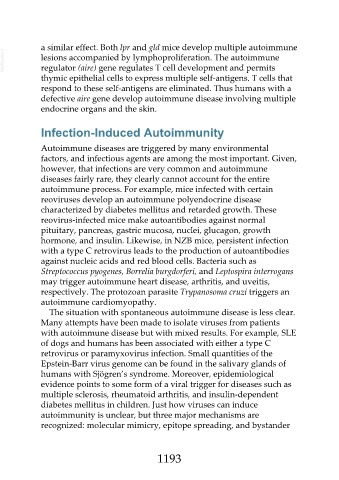Page 1193 - Veterinary Immunology, 10th Edition
P. 1193
a similar effect. Both lpr and gld mice develop multiple autoimmune
VetBooks.ir lesions accompanied by lymphoproliferation. The autoimmune
regulator (aire) gene regulates T cell development and permits
thymic epithelial cells to express multiple self-antigens. T cells that
respond to these self-antigens are eliminated. Thus humans with a
defective aire gene develop autoimmune disease involving multiple
endocrine organs and the skin.
Infection-Induced Autoimmunity
Autoimmune diseases are triggered by many environmental
factors, and infectious agents are among the most important. Given,
however, that infections are very common and autoimmune
diseases fairly rare, they clearly cannot account for the entire
autoimmune process. For example, mice infected with certain
reoviruses develop an autoimmune polyendocrine disease
characterized by diabetes mellitus and retarded growth. These
reovirus-infected mice make autoantibodies against normal
pituitary, pancreas, gastric mucosa, nuclei, glucagon, growth
hormone, and insulin. Likewise, in NZB mice, persistent infection
with a type C retrovirus leads to the production of autoantibodies
against nucleic acids and red blood cells. Bacteria such as
Streptococcus pyogenes, Borrelia burgdorferi, and Leptospira interrogans
may trigger autoimmune heart disease, arthritis, and uveitis,
respectively. The protozoan parasite Trypanosoma cruzi triggers an
autoimmune cardiomyopathy.
The situation with spontaneous autoimmune disease is less clear.
Many attempts have been made to isolate viruses from patients
with autoimmune disease but with mixed results. For example, SLE
of dogs and humans has been associated with either a type C
retrovirus or paramyxovirus infection. Small quantities of the
Epstein-Barr virus genome can be found in the salivary glands of
humans with Sjögren’s syndrome. Moreover, epidemiological
evidence points to some form of a viral trigger for diseases such as
multiple sclerosis, rheumatoid arthritis, and insulin-dependent
diabetes mellitus in children. Just how viruses can induce
autoimmunity is unclear, but three major mechanisms are
recognized: molecular mimicry, epitope spreading, and bystander
1193

